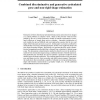33 search results - page 3 / 7 » Articulated body deformation from range scan data |
AMDO
2006
Springer
13 years 8 months ago
2006
Springer
This paper presents a new scheme for acquiring 3D kinematic structure and motion from time-series volume data, in particular, focusing on human body. Our basic strategy is to first...
NIPS
2007
13 years 6 months ago
2007
Estimation of three-dimensional articulated human pose and motion from images is a central problem in computer vision. Much of the previous work has been limited by the use of cru...
3DPVT
2004
IEEE
13 years 8 months ago
2004
IEEE
We present a non-rigid alignment algorithm for aligning high-resolution range data in the presence of lowfrequency deformations, such as those caused by scanner calibration error....
IJSR
2010
13 years 3 months ago
2010
People detection is a key capacity for robotics systems that have to interact with humans. This paper addresses the problem of detecting people using multiple layers of 2D laser ra...
MICCAI
2003
Springer
14 years 5 months ago
2003
Springer
A novel brain shift tracking protocol is introduced in this paper which utilizes laser range scan (LRS) data and 2D deformable image registration. This protocol builds on previous ...

